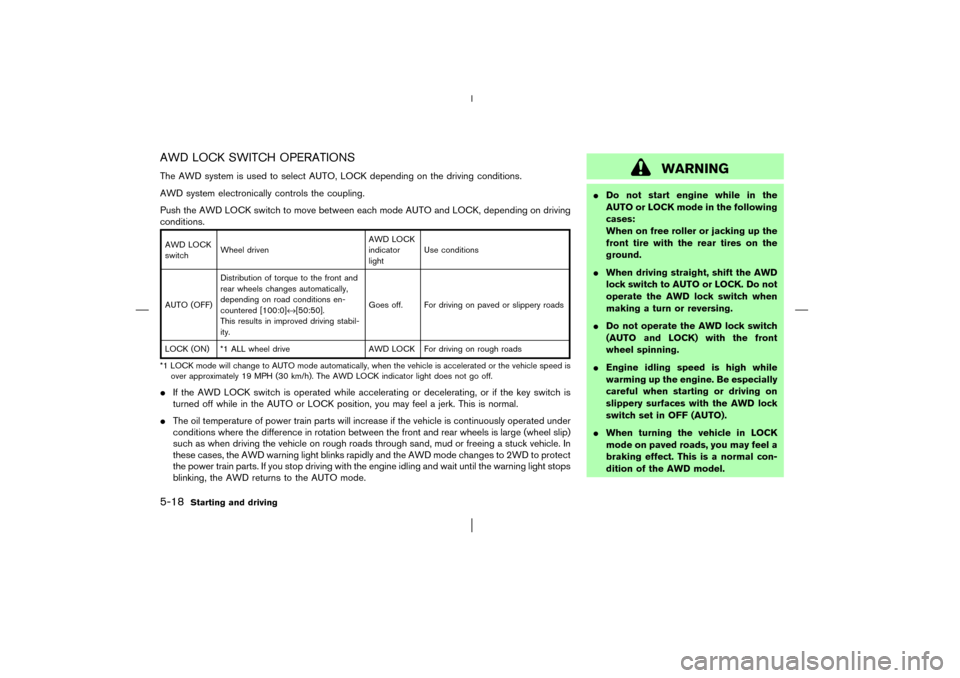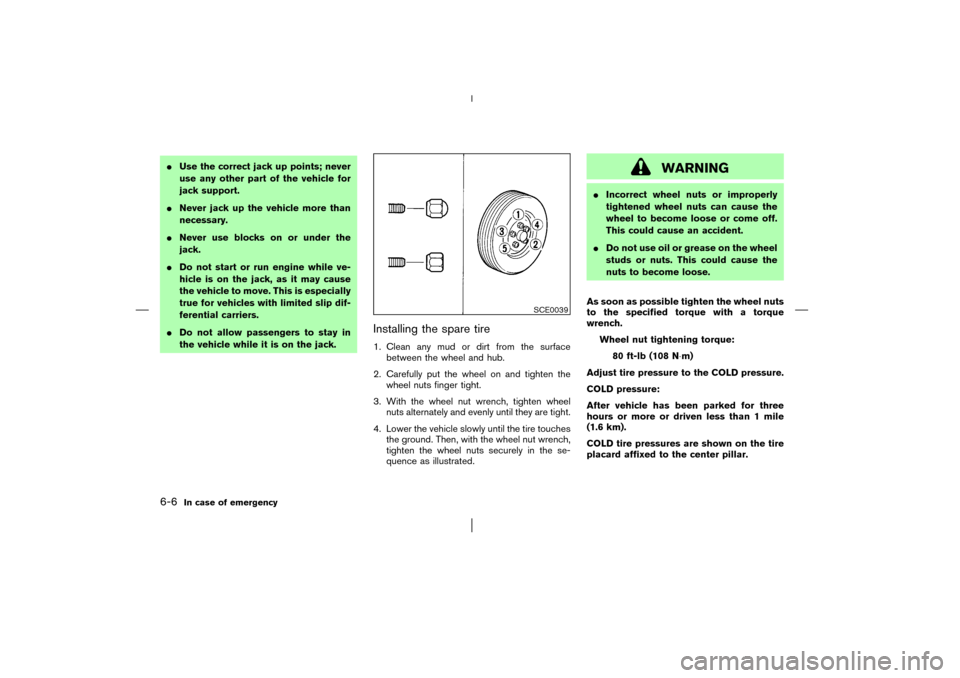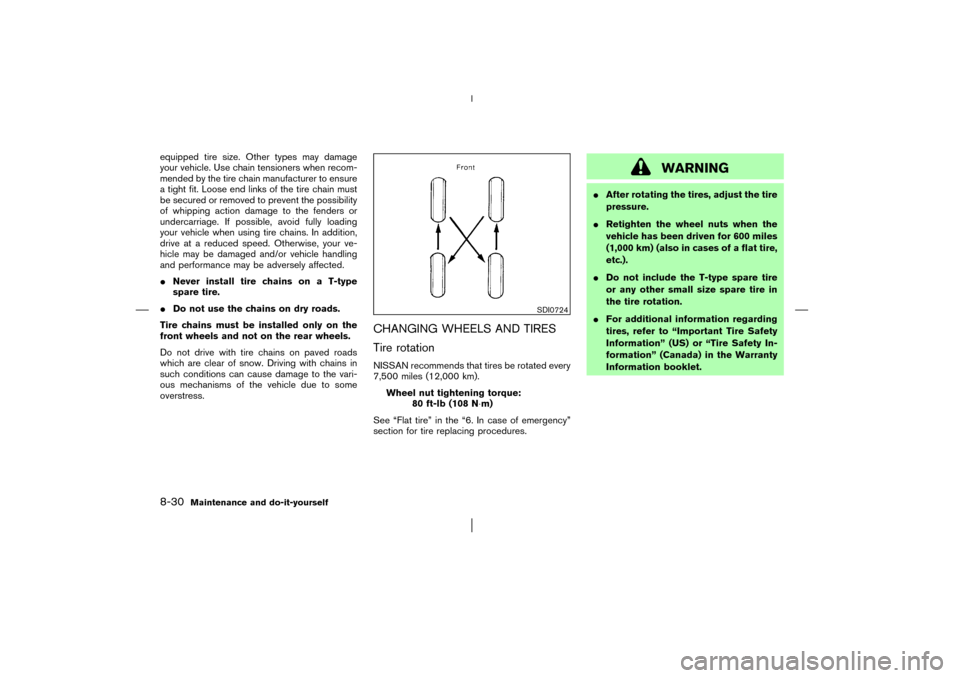Page 167 of 265

AWD LOCK SWITCH OPERATIONSThe AWD system is used to select AUTO, LOCK depending on the driving conditions.
AWD system electronically controls the coupling.
Push the AWD LOCK switch to move between each mode AUTO and LOCK, depending on driving
conditions.AWD LOCK
switchWheel drivenAWD LOCK
indicator
lightUse conditions
AUTO (OFF)Distribution of torque to the front and
rear wheels changes automatically,
depending on road conditions en-
countered [100:0]↔[50:50].
This results in improved driving stabil-
ity.Goes off. For driving on paved or slippery roads
LOCK (ON) *1 ALL wheel drive AWD LOCK For driving on rough roads
*1 LOCK mode will change to AUTO mode automatically, when the vehicle is accelerated or the vehicle speed is
over approximately 19 MPH (30 km/h). The AWD LOCK indicator light does not go off.�If the AWD LOCK switch is operated while accelerating or decelerating, or if the key switch is
turned off while in the AUTO or LOCK position, you may feel a jerk. This is normal.
�The oil temperature of power train parts will increase if the vehicle is continuously operated under
conditions where the difference in rotation between the front and rear wheels is large (wheel slip)
such as when driving the vehicle on rough roads through sand, mud or freeing a stuck vehicle. In
these cases, the AWD warning light blinks rapidly and the AWD mode changes to 2WD to protect
the power train parts. If you stop driving with the engine idling and wait until the warning light stops
blinking, the AWD returns to the AUTO mode.
WARNING
�Do not start engine while in the
AUTO or LOCK mode in the following
cases:
When on free roller or jacking up the
front tire with the rear tires on the
ground.
�When driving straight, shift the AWD
lock switch to AUTO or LOCK. Do not
operate the AWD lock switch when
making a turn or reversing.
�Do not operate the AWD lock switch
(AUTO and LOCK) with the front
wheel spinning.
�Engine idling speed is high while
warming up the engine. Be especially
careful when starting or driving on
slippery surfaces with the AWD lock
switch set in OFF (AUTO).
�When turning the vehicle in LOCK
mode on paved roads, you may feel a
braking effect. This is a normal con-
dition of the AWD model.
5-18
Starting and driving
�
03.1.28/Z50-D/V5.0
�
Page 181 of 265

�Use the correct jack up points; never
use any other part of the vehicle for
jack support.
�Never jack up the vehicle more than
necessary.
�Never use blocks on or under the
jack.
�Do not start or run engine while ve-
hicle is on the jack, as it may cause
the vehicle to move. This is especially
true for vehicles with limited slip dif-
ferential carriers.
�Do not allow passengers to stay in
the vehicle while it is on the jack.
Installing the spare tire1. Clean any mud or dirt from the surface
between the wheel and hub.
2. Carefully put the wheel on and tighten the
wheel nuts finger tight.
3. With the wheel nut wrench, tighten wheel
nuts alternately and evenly until they are tight.
4. Lower the vehicle slowly until the tire touches
the ground. Then, with the wheel nut wrench,
tighten the wheel nuts securely in the se-
quence as illustrated.
WARNING
�Incorrect wheel nuts or improperly
tightened wheel nuts can cause the
wheel to become loose or come off.
This could cause an accident.
�Do not use oil or grease on the wheel
studs or nuts. This could cause the
nuts to become loose.
As soon as possible tighten the wheel nuts
to the specified torque with a torque
wrench.
Wheel nut tightening torque:
80 ft-lb (108 N⋅m)
Adjust tire pressure to the COLD pressure.
COLD pressure:
After vehicle has been parked for three
hours or more or driven less than 1 mile
(1.6 km).
COLD tire pressures are shown on the tire
placard affixed to the center pillar.
SCE0039
6-6
In case of emergency
�
03.1.28/Z50-D/V5.0
�
Page 225 of 265

equipped tire size. Other types may damage
your vehicle. Use chain tensioners when recom-
mended by the tire chain manufacturer to ensure
a tight fit. Loose end links of the tire chain must
be secured or removed to prevent the possibility
of whipping action damage to the fenders or
undercarriage. If possible, avoid fully loading
your vehicle when using tire chains. In addition,
drive at a reduced speed. Otherwise, your ve-
hicle may be damaged and/or vehicle handling
and performance may be adversely affected.
�Never install tire chains on a T-type
spare tire.
�Do not use the chains on dry roads.
Tire chains must be installed only on the
front wheels and not on the rear wheels.
Do not drive with tire chains on paved roads
which are clear of snow. Driving with chains in
such conditions can cause damage to the vari-
ous mechanisms of the vehicle due to some
overstress.
CHANGING WHEELS AND TIRES
Tire rotationNISSAN recommends that tires be rotated every
7,500 miles (12,000 km).
Wheel nut tightening torque:
80 ft-lb (108 N⋅m)
See “Flat tire” in the “6. In case of emergency”
section for tire replacing procedures.
WARNING
�After rotating the tires, adjust the tire
pressure.
�Retighten the wheel nuts when the
vehicle has been driven for 600 miles
(1,000 km) (also in cases of a flat tire,
etc.).
�Do not include the T-type spare tire
or any other small size spare tire in
the tire rotation.
�For additional information regarding
tires, refer to “Important Tire Safety
Information” (US) or “Tire Safety In-
formation” (Canada) in the Warranty
Information booklet.
SDI0724
8-30
Maintenance and do-it-yourself
�
03.1.28/Z50-D/V5.0
�